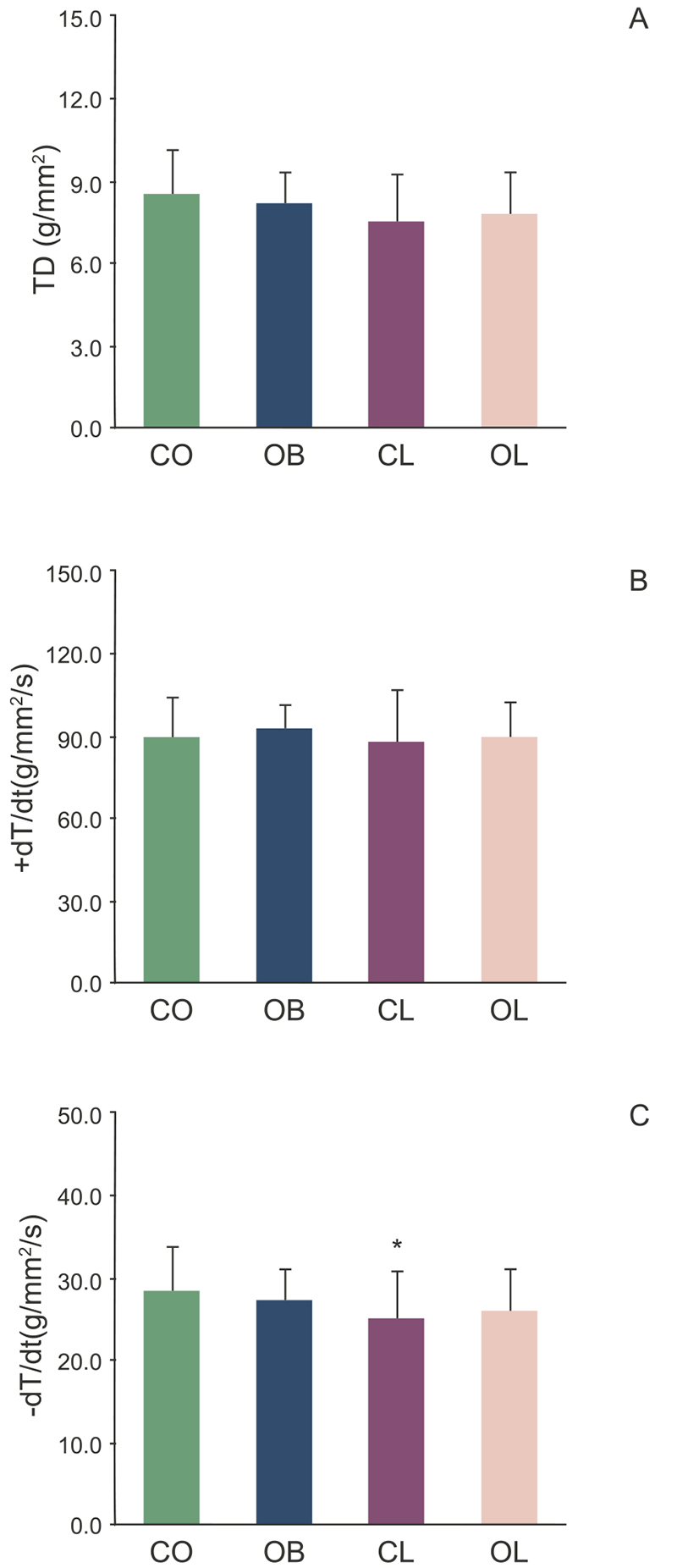Volume 115, Nº 1, July 2020
DOI: https://doi.org/10.36660/abc.20190131
ORIGINAL ARTICLE
AT1 Receptor Blockade Improves Myocardial Functional Performance in Obesity
Silvio Assis de Oliveira-Junior
Nayara de Araújo Muzili
Marianna Rabelo de Carvalho
Gabriel Elias Ota
Camila Souza de Morais
Larissa Fregapani da Costa Vieira
Mateus Oliveira Ortiz
Dijon H. S. Campos
Marcelo Diacardia Mariano Cezar
Marina Politi Okoshi
Katashi Okoshi
Antonio C. Cicogna
Paula Felippe Martinez

Figure 1 – Functional papillary muscle assessment at baseline with extracellular [Ca 2+] equal to 2.5 mM; results in mean±SD; (A) DT: maximum developed tension; (B) +dT/dt: maximum DT variation speed; (C) –dT/dt: maximum DT decrease; CO: Control group; OB: Obese group; CL: Control Losartan group; OL: Obese Losartan group. *p<0.05 compared to CO; Two-Way ANOVA and Tukey Test.
Abstract
Background: Obesity has been associated with chronic activation of the renin-angiotensin-aldosterone system and with significant changes in cardiac performance.
Objective: To assess the impact of a blockade of angiotensin-II receptor type 1 (AT1 receptor) on morphology and on myocardial functional performance in rats with high-fat diet- induced obesity.
Methods: Wistar rats (n=48) were submitted to control (2.9 kcal/g) or high-fat (3.6 kcal/g) diet for 20 weeks. After the 16th week they were divided into four groups: Control (CO), Obese (OB), Control Losartan (CL) and Obese Losartan (OL). CL and OL received losartan (30 mg/kg/day) in drinking water for four weeks. Subsequently, body composition, systolic blood pressure (SBP) and echocardiographic variables were analyzed. Papillary muscle function was assessed at baseline with 2.50 mM calcium concentration ([Ca2+]o) and after inotropic maneuvers: post-pause potentiation (PPP), [Ca2+]o elevation, and during beta-adrenergic stimulation with isoproterenol. Analysis of the results was performed by the Two-Way ANOVA and by the appropriate comparison test. The level of significance was set at 5%.
Results: Although SBP change had been not maintained at the end of the experiment, obesity was associated with cardiac hypertrophy and with increased left ventricle posterior wall shortening velocity. In the study of papillary muscles in basal condition, CL showed lower developed tension maximum negative variation velocity (-dT/dt) than CO. The 60s PPP promoted lower -dT/dt and maximum developed tension (DT) in OB and CL compared with CO, and higher relative DT variation and maximum positive variation velocity (+dT/dt) in OL compared with CL and OB. Under 1.5, 2.0, and 2.5mM [Ca2+]o, the OL group showed higher -dT/dt than CL.
Conclusion: Losartan improves myocardial function in high-fat diet-induced obesity. (Arq Bras Cardiol. 2020; 115(1):17-28)
Keywords: Cardiovascular Diseases; Obesity; Losartan/therapeutic use; Angiotensin II Type 1 Receptor Blockers/therapeutic use; Rats; Diet, High-fat/methods.















